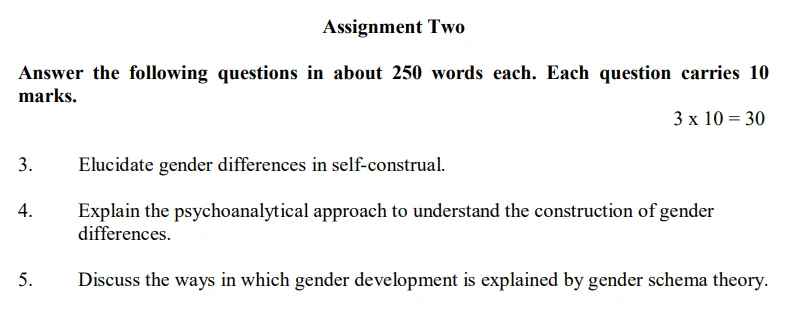BPCG 176 SOLVED IGNOU ASSIGNMENT FREE PART 2

Welcome to the BPCG 176 SOLVED IGNOU ASSIGNMENT FREE PART 2 TMA. In Assignment Two, we simplify the process with concise answers to three pivotal questions. With each response capped at 250 words and 10 marks per question, effortlessly grasp the nuances of gender differences in self-construal, the psychoanalytical approach to gender construction, and the insights provided by gender schema theory in explaining gender development. Our IGNOU Solved Assignments 2024 for this section serve as your creative guide.

Answer the following questions in about 250 words each. Each question carries 10 marks.
Q.3 Elucidate gender differences in self-construal.
Ans. Gender differences in self-construal refer to variations in how individuals, based on their gender, perceive and express their sense of self within social and cultural contexts. Self-construal is a psychological concept that captures the extent to which individuals define themselves in relation to others and the surrounding environment. Two primary types of self-construal are often discussed in the literature: independent self-construal and interdependent self-construal.
1. Independent Self-Construal (Individualism):
– Commonly associated with Western cultural norms, independent self-construal emphasizes autonomy, personal achievement, and the uniqueness of the individual. In this context, gender studies often suggest that men, in comparison to women, may exhibit a slightly stronger inclination toward independent self-construal. This may manifest in a focus on personal goals, individual success, and assertiveness.
2. Interdependent Self-Construal (Collectivism):
– Interdependent self-construal, associated with many Eastern cultures, emphasizes interconnectedness, relational harmony, and the importance of group identity. Research suggests that women, on average, may lean towards interdependent self-construal more than men. This can manifest in a focus on relationships, collaboration, and consideration of others’ needs and expectations.
Cultural and Contextual Influences:
– It’s important to note that these gender differences in self-construal are not universal and can be influenced by cultural and situational factors. Contexts that encourage independence or collectivism, and cultural norms that prioritize certain aspects of selfhood, can impact how individuals, regardless of gender, express their self-construal.
Implications:
– Understanding gender differences in self-construal is valuable in various fields, including psychology, sociology, and communication studies. It helps researchers and practitioners appreciate diverse perspectives and tailor interventions or communication strategies accordingly. Moreover, recognizing these differences challenges stereotypes and fosters a more nuanced understanding of gender and identity.
Challenges to Generalizations:
– While broad patterns may emerge, individual differences within each gender group are substantial. Many men may exhibit interdependent self-construal, and many women may strongly identify with independent self-construal. Recognizing and respecting this diversity is crucial for avoiding stereotypes and supporting individuals in their unique experiences of selfhood.
In summary, gender differences in self-construal reflect variations in how individuals, influenced by societal and cultural factors, define their identities in relation to others. Acknowledging these differences enhances our understanding of diverse perspectives within gender groups and promotes more inclusive and culturally sensitive approaches in various domains.
Q.4 Explain the psychoanalytical approach to understand the construction of gender differences.
Ans. The psychoanalytic approach, pioneered by Sigmund Freud and further developed by later theorists, offers a psychological framework to understand the construction of gender differences. This approach delves into the impact of unconscious processes, early childhood experiences, and the role of the family in shaping an individual’s gender identity.
1. Freud’s Psychosexual Development:
– Freud proposed that children pass through distinct psychosexual stages: oral, anal, phallic, latent, and genital. The phallic stage, occurring around ages 3-6, is pivotal for understanding gender differences. Freud introduced the concept of the Oedipus complex, suggesting that boys develop unconscious desires for their mothers and identify with their fathers. This process contributes to the internalization of gender roles.
2. Gender Identity and Role Formation:
– According to psychoanalytic theory, children develop a gender identity by identifying with the same-sex parent. This identification influences the internalization of gender roles—socially defined behaviors associated with being male or female. Girls experience a parallel process called the Electra complex.
3. Role of Unconscious Processes:
– The psychoanalytic approach emphasizes the role of unconscious processes in shaping gender differences. Unresolved conflicts from early childhood, particularly related to gender identity, can influence an individual’s emotions, behaviors, and interpersonal relationships in adulthood.
4. Critiques and Expansions:
– Critics argue that Freud’s theory is overly focused on biological determinism and heteronormativity. Contemporary psychoanalytic scholars, such as Nancy Chodorow and Jessica Benjamin, have expanded the theory to address these limitations. Chodorow, for example, explored the role of early mothering in the development of gender identity.
5. Socialization and Beyond:
– While psychoanalysis highlights the importance of early childhood experiences, it is crucial to acknowledge the role of broader socialization processes in constructing gender differences. Cultural, societal, and environmental factors also play significant roles in shaping individuals’ gender identities and behaviors.
In conclusion, the psychoanalytic approach offers insights into the construction of gender differences by emphasizing unconscious processes, early childhood experiences, and family dynamics. While its contributions have been influential, contemporary perspectives within psychology recognize the need to integrate social, cultural, and environmental factors to provide a more comprehensive understanding of gender identity and roles.
Q.5 Discuss the ways in which gender development is explained by gender schema theory.
Ans. Gender schema theory, proposed by Sandra Bem, provides a cognitive framework for understanding how individuals acquire and internalize gender-related information. It goes beyond traditional psychoanalytic perspectives and posits that children actively organize and process information about gender, influencing their perceptions and behaviors. Here are key ways in which gender development is explained by gender schema theory:
1. Formation of Gender Schemas:
– According to the theory, individuals develop mental structures called gender schemas that organize information related to gender. These schemas include expectations, beliefs, and behaviors associated with being male or female.
2. Cognitive Filtering:
– Gender schema theory suggests that children selectively attend to, encode, and remember information consistent with their gender schema. This cognitive filtering process shapes their understanding of gender roles and stereotypes.
3. Influence on Perceptions:
– Gender schemas influence how individuals perceive and interpret the world around them. For instance, a child with a strong feminine gender schema may interpret activities or objects as being more suitable for girls, and vice versa.
4. Impact on Memory and Recall:
– The theory proposes that individuals are more likely to remember information that aligns with their gender schema. This selective memory contributes to the reinforcement and perpetuation of gender stereotypes.
5. Socialization and Gender Identity:
– Gender schema theory highlights the role of socialization in shaping gender schemas. As children are exposed to societal messages, media, and interpersonal interactions, they develop and refine their gender schemas, contributing to the formation of gender identity.
6. Flexibility and Change:
– Unlike earlier theories that suggested rigid gender identity development, gender schema theory allows for flexibility and change. Individuals can adjust their gender schemas based on new information and experiences, providing a more dynamic perspective on gender development.
7. Gender-Related Behaviors:
– Gender schema theory posits that gender-related behaviors are guided by individuals’ internalized schemas. This includes the adoption of behaviors perceived as appropriate for one’s gender and the avoidance of those associated with the opposite gender.
8. Impact on Socialization Practices:
– The theory suggests that gender schemas influence how individuals engage in and contribute to their own socialization. Children actively seek out gender-congruent activities and relationships, reinforcing their gender schema through their choices and interactions.
In summary, gender schema theory offers a cognitive explanation for the development of gender identity and behaviors. It emphasizes the active role of individuals in processing and organizing gender-related information, shaping their perceptions, and influencing their interactions with the social environment.
Also See This: BPCG 176 SOLVED IGNOU ASSIGNMENT FREE PART 3







